A Detailed Analysis of Gothic Elements in Edgar Allan Poe's The Raven
VerifiedAdded on 2023/01/19
|7
|2084
|1
Essay
AI Summary
This essay provides a comprehensive analysis of the gothic elements present in Edgar Allan Poe's renowned poem, "The Raven." The paper delves into the core themes that define the gothic genre, including death, madness, and the presence of the supernatural. It examines how Poe masterfully employs these elements to create a haunting and evocative atmosphere, contributing to the poem's enduring appeal. The analysis explores the symbolic significance of the raven itself, the narrator's descent into despair, and the portrayal of Lenore's death. The essay also discusses the poem's setting, atmosphere, and the use of language to enhance the gothic experience, providing readers with a deeper understanding of Poe's artistry and the poem's lasting impact on literature.
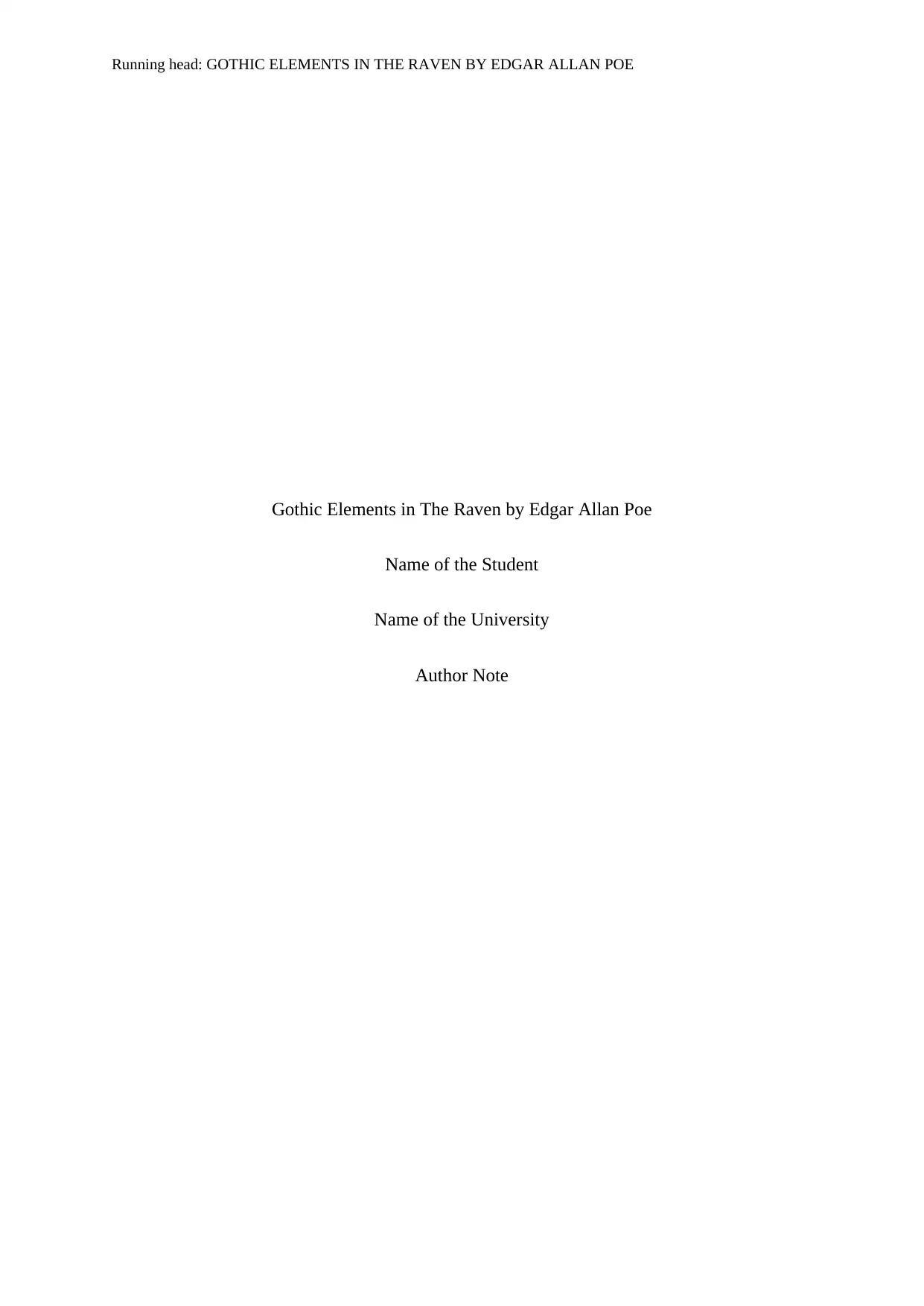
Running head: GOTHIC ELEMENTS IN THE RAVEN BY EDGAR ALLAN POE
Gothic Elements in The Raven by Edgar Allan Poe
Name of the Student
Name of the University
Author Note
Gothic Elements in The Raven by Edgar Allan Poe
Name of the Student
Name of the University
Author Note
Secure Best Marks with AI Grader
Need help grading? Try our AI Grader for instant feedback on your assignments.
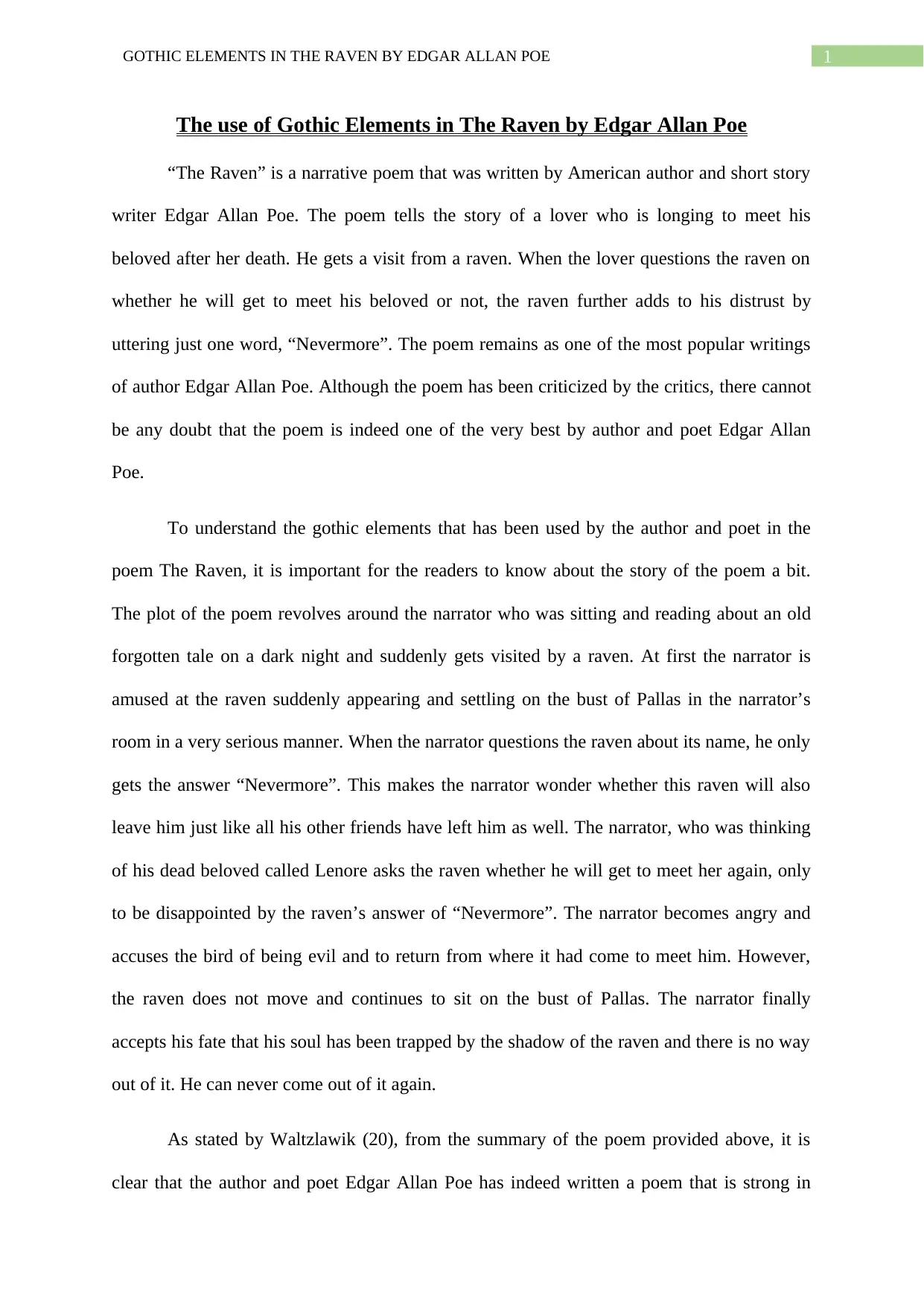
1GOTHIC ELEMENTS IN THE RAVEN BY EDGAR ALLAN POE
The use of Gothic Elements in The Raven by Edgar Allan Poe
“The Raven” is a narrative poem that was written by American author and short story
writer Edgar Allan Poe. The poem tells the story of a lover who is longing to meet his
beloved after her death. He gets a visit from a raven. When the lover questions the raven on
whether he will get to meet his beloved or not, the raven further adds to his distrust by
uttering just one word, “Nevermore”. The poem remains as one of the most popular writings
of author Edgar Allan Poe. Although the poem has been criticized by the critics, there cannot
be any doubt that the poem is indeed one of the very best by author and poet Edgar Allan
Poe.
To understand the gothic elements that has been used by the author and poet in the
poem The Raven, it is important for the readers to know about the story of the poem a bit.
The plot of the poem revolves around the narrator who was sitting and reading about an old
forgotten tale on a dark night and suddenly gets visited by a raven. At first the narrator is
amused at the raven suddenly appearing and settling on the bust of Pallas in the narrator’s
room in a very serious manner. When the narrator questions the raven about its name, he only
gets the answer “Nevermore”. This makes the narrator wonder whether this raven will also
leave him just like all his other friends have left him as well. The narrator, who was thinking
of his dead beloved called Lenore asks the raven whether he will get to meet her again, only
to be disappointed by the raven’s answer of “Nevermore”. The narrator becomes angry and
accuses the bird of being evil and to return from where it had come to meet him. However,
the raven does not move and continues to sit on the bust of Pallas. The narrator finally
accepts his fate that his soul has been trapped by the shadow of the raven and there is no way
out of it. He can never come out of it again.
As stated by Waltzlawik (20), from the summary of the poem provided above, it is
clear that the author and poet Edgar Allan Poe has indeed written a poem that is strong in
The use of Gothic Elements in The Raven by Edgar Allan Poe
“The Raven” is a narrative poem that was written by American author and short story
writer Edgar Allan Poe. The poem tells the story of a lover who is longing to meet his
beloved after her death. He gets a visit from a raven. When the lover questions the raven on
whether he will get to meet his beloved or not, the raven further adds to his distrust by
uttering just one word, “Nevermore”. The poem remains as one of the most popular writings
of author Edgar Allan Poe. Although the poem has been criticized by the critics, there cannot
be any doubt that the poem is indeed one of the very best by author and poet Edgar Allan
Poe.
To understand the gothic elements that has been used by the author and poet in the
poem The Raven, it is important for the readers to know about the story of the poem a bit.
The plot of the poem revolves around the narrator who was sitting and reading about an old
forgotten tale on a dark night and suddenly gets visited by a raven. At first the narrator is
amused at the raven suddenly appearing and settling on the bust of Pallas in the narrator’s
room in a very serious manner. When the narrator questions the raven about its name, he only
gets the answer “Nevermore”. This makes the narrator wonder whether this raven will also
leave him just like all his other friends have left him as well. The narrator, who was thinking
of his dead beloved called Lenore asks the raven whether he will get to meet her again, only
to be disappointed by the raven’s answer of “Nevermore”. The narrator becomes angry and
accuses the bird of being evil and to return from where it had come to meet him. However,
the raven does not move and continues to sit on the bust of Pallas. The narrator finally
accepts his fate that his soul has been trapped by the shadow of the raven and there is no way
out of it. He can never come out of it again.
As stated by Waltzlawik (20), from the summary of the poem provided above, it is
clear that the author and poet Edgar Allan Poe has indeed written a poem that is strong in
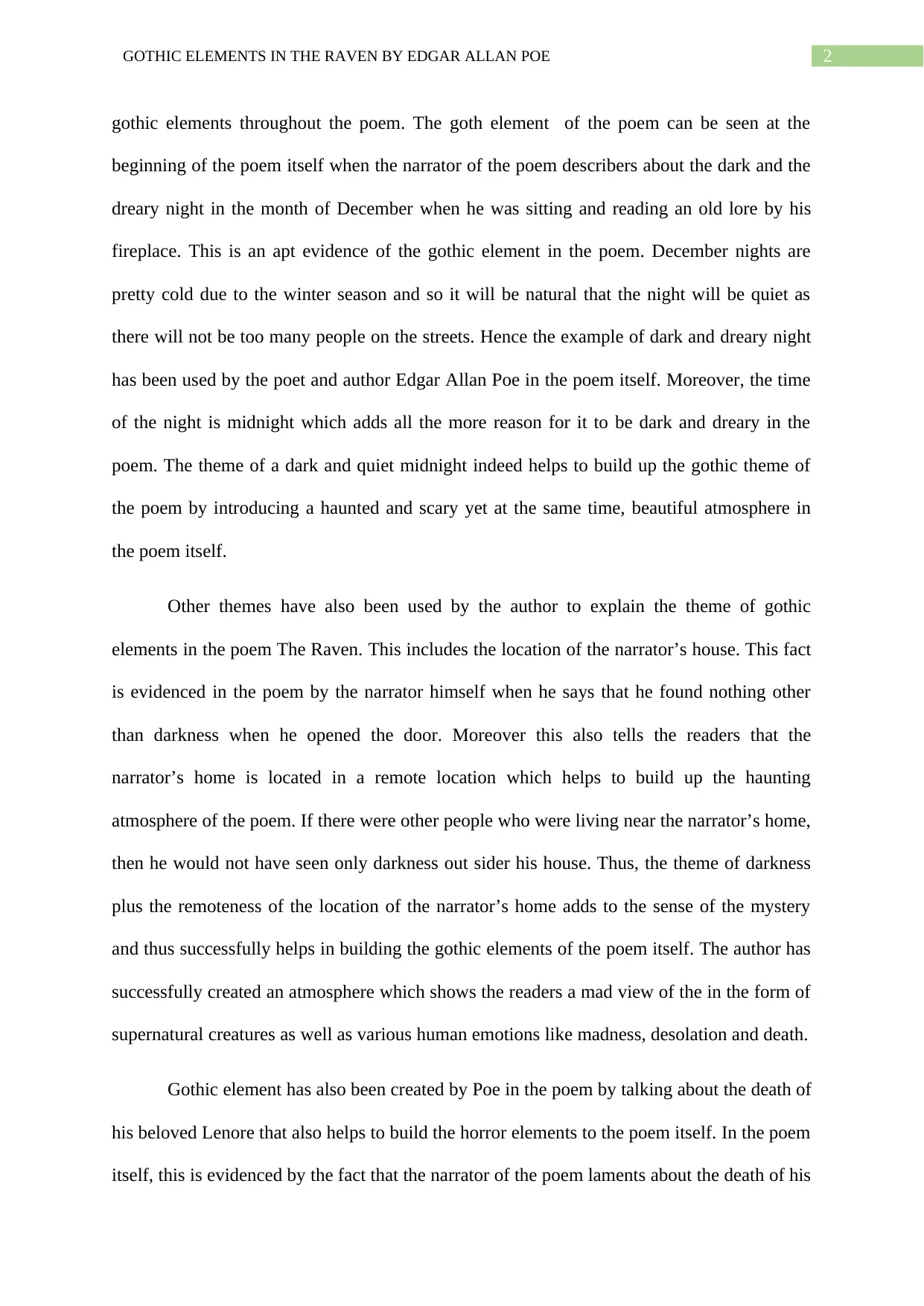
2GOTHIC ELEMENTS IN THE RAVEN BY EDGAR ALLAN POE
gothic elements throughout the poem. The goth element of the poem can be seen at the
beginning of the poem itself when the narrator of the poem describers about the dark and the
dreary night in the month of December when he was sitting and reading an old lore by his
fireplace. This is an apt evidence of the gothic element in the poem. December nights are
pretty cold due to the winter season and so it will be natural that the night will be quiet as
there will not be too many people on the streets. Hence the example of dark and dreary night
has been used by the poet and author Edgar Allan Poe in the poem itself. Moreover, the time
of the night is midnight which adds all the more reason for it to be dark and dreary in the
poem. The theme of a dark and quiet midnight indeed helps to build up the gothic theme of
the poem by introducing a haunted and scary yet at the same time, beautiful atmosphere in
the poem itself.
Other themes have also been used by the author to explain the theme of gothic
elements in the poem The Raven. This includes the location of the narrator’s house. This fact
is evidenced in the poem by the narrator himself when he says that he found nothing other
than darkness when he opened the door. Moreover this also tells the readers that the
narrator’s home is located in a remote location which helps to build up the haunting
atmosphere of the poem. If there were other people who were living near the narrator’s home,
then he would not have seen only darkness out sider his house. Thus, the theme of darkness
plus the remoteness of the location of the narrator’s home adds to the sense of the mystery
and thus successfully helps in building the gothic elements of the poem itself. The author has
successfully created an atmosphere which shows the readers a mad view of the in the form of
supernatural creatures as well as various human emotions like madness, desolation and death.
Gothic element has also been created by Poe in the poem by talking about the death of
his beloved Lenore that also helps to build the horror elements to the poem itself. In the poem
itself, this is evidenced by the fact that the narrator of the poem laments about the death of his
gothic elements throughout the poem. The goth element of the poem can be seen at the
beginning of the poem itself when the narrator of the poem describers about the dark and the
dreary night in the month of December when he was sitting and reading an old lore by his
fireplace. This is an apt evidence of the gothic element in the poem. December nights are
pretty cold due to the winter season and so it will be natural that the night will be quiet as
there will not be too many people on the streets. Hence the example of dark and dreary night
has been used by the poet and author Edgar Allan Poe in the poem itself. Moreover, the time
of the night is midnight which adds all the more reason for it to be dark and dreary in the
poem. The theme of a dark and quiet midnight indeed helps to build up the gothic theme of
the poem by introducing a haunted and scary yet at the same time, beautiful atmosphere in
the poem itself.
Other themes have also been used by the author to explain the theme of gothic
elements in the poem The Raven. This includes the location of the narrator’s house. This fact
is evidenced in the poem by the narrator himself when he says that he found nothing other
than darkness when he opened the door. Moreover this also tells the readers that the
narrator’s home is located in a remote location which helps to build up the haunting
atmosphere of the poem. If there were other people who were living near the narrator’s home,
then he would not have seen only darkness out sider his house. Thus, the theme of darkness
plus the remoteness of the location of the narrator’s home adds to the sense of the mystery
and thus successfully helps in building the gothic elements of the poem itself. The author has
successfully created an atmosphere which shows the readers a mad view of the in the form of
supernatural creatures as well as various human emotions like madness, desolation and death.
Gothic element has also been created by Poe in the poem by talking about the death of
his beloved Lenore that also helps to build the horror elements to the poem itself. In the poem
itself, this is evidenced by the fact that the narrator of the poem laments about the death of his
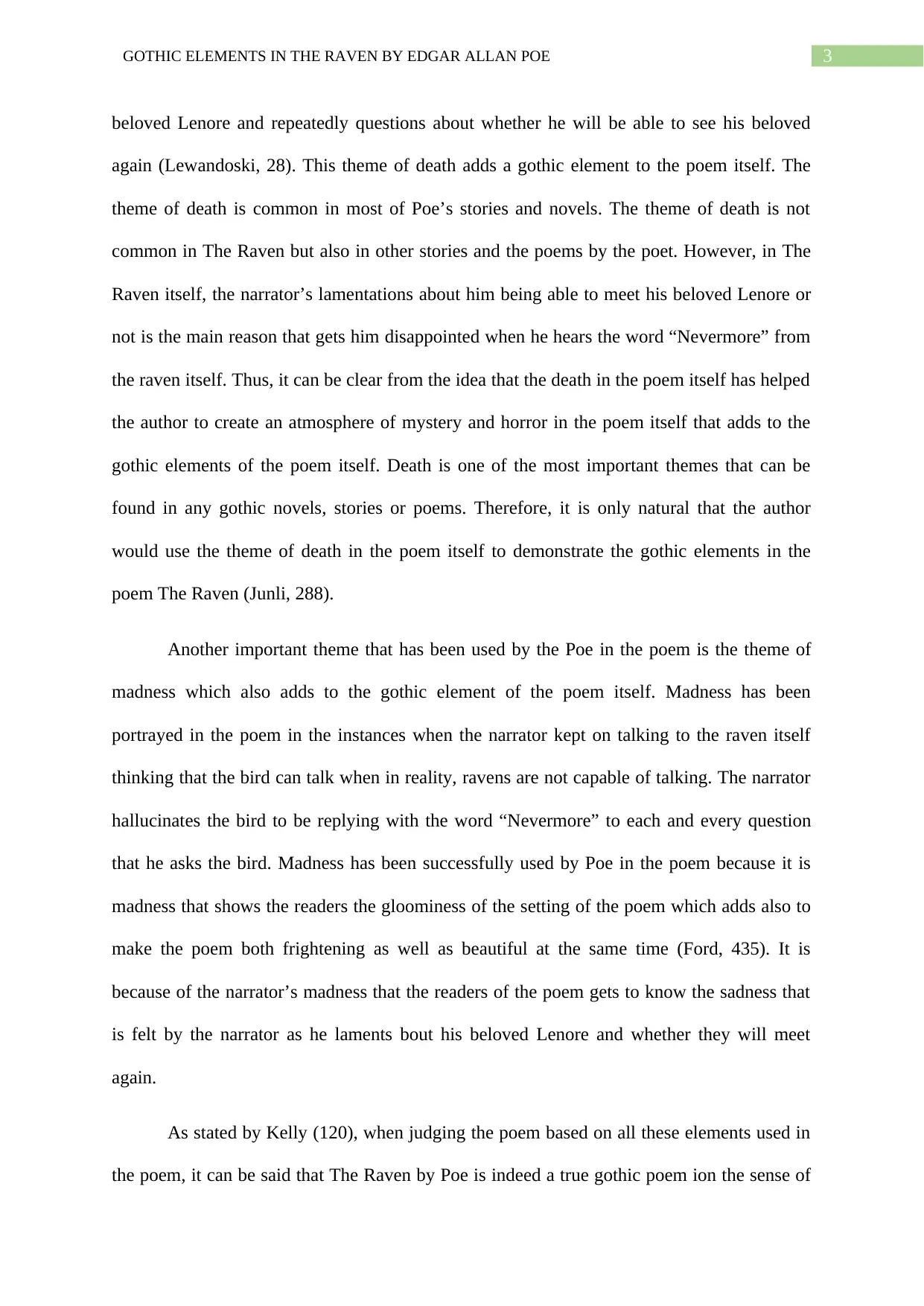
3GOTHIC ELEMENTS IN THE RAVEN BY EDGAR ALLAN POE
beloved Lenore and repeatedly questions about whether he will be able to see his beloved
again (Lewandoski, 28). This theme of death adds a gothic element to the poem itself. The
theme of death is common in most of Poe’s stories and novels. The theme of death is not
common in The Raven but also in other stories and the poems by the poet. However, in The
Raven itself, the narrator’s lamentations about him being able to meet his beloved Lenore or
not is the main reason that gets him disappointed when he hears the word “Nevermore” from
the raven itself. Thus, it can be clear from the idea that the death in the poem itself has helped
the author to create an atmosphere of mystery and horror in the poem itself that adds to the
gothic elements of the poem itself. Death is one of the most important themes that can be
found in any gothic novels, stories or poems. Therefore, it is only natural that the author
would use the theme of death in the poem itself to demonstrate the gothic elements in the
poem The Raven (Junli, 288).
Another important theme that has been used by the Poe in the poem is the theme of
madness which also adds to the gothic element of the poem itself. Madness has been
portrayed in the poem in the instances when the narrator kept on talking to the raven itself
thinking that the bird can talk when in reality, ravens are not capable of talking. The narrator
hallucinates the bird to be replying with the word “Nevermore” to each and every question
that he asks the bird. Madness has been successfully used by Poe in the poem because it is
madness that shows the readers the gloominess of the setting of the poem which adds also to
make the poem both frightening as well as beautiful at the same time (Ford, 435). It is
because of the narrator’s madness that the readers of the poem gets to know the sadness that
is felt by the narrator as he laments bout his beloved Lenore and whether they will meet
again.
As stated by Kelly (120), when judging the poem based on all these elements used in
the poem, it can be said that The Raven by Poe is indeed a true gothic poem ion the sense of
beloved Lenore and repeatedly questions about whether he will be able to see his beloved
again (Lewandoski, 28). This theme of death adds a gothic element to the poem itself. The
theme of death is common in most of Poe’s stories and novels. The theme of death is not
common in The Raven but also in other stories and the poems by the poet. However, in The
Raven itself, the narrator’s lamentations about him being able to meet his beloved Lenore or
not is the main reason that gets him disappointed when he hears the word “Nevermore” from
the raven itself. Thus, it can be clear from the idea that the death in the poem itself has helped
the author to create an atmosphere of mystery and horror in the poem itself that adds to the
gothic elements of the poem itself. Death is one of the most important themes that can be
found in any gothic novels, stories or poems. Therefore, it is only natural that the author
would use the theme of death in the poem itself to demonstrate the gothic elements in the
poem The Raven (Junli, 288).
Another important theme that has been used by the Poe in the poem is the theme of
madness which also adds to the gothic element of the poem itself. Madness has been
portrayed in the poem in the instances when the narrator kept on talking to the raven itself
thinking that the bird can talk when in reality, ravens are not capable of talking. The narrator
hallucinates the bird to be replying with the word “Nevermore” to each and every question
that he asks the bird. Madness has been successfully used by Poe in the poem because it is
madness that shows the readers the gloominess of the setting of the poem which adds also to
make the poem both frightening as well as beautiful at the same time (Ford, 435). It is
because of the narrator’s madness that the readers of the poem gets to know the sadness that
is felt by the narrator as he laments bout his beloved Lenore and whether they will meet
again.
As stated by Kelly (120), when judging the poem based on all these elements used in
the poem, it can be said that The Raven by Poe is indeed a true gothic poem ion the sense of
Secure Best Marks with AI Grader
Need help grading? Try our AI Grader for instant feedback on your assignments.
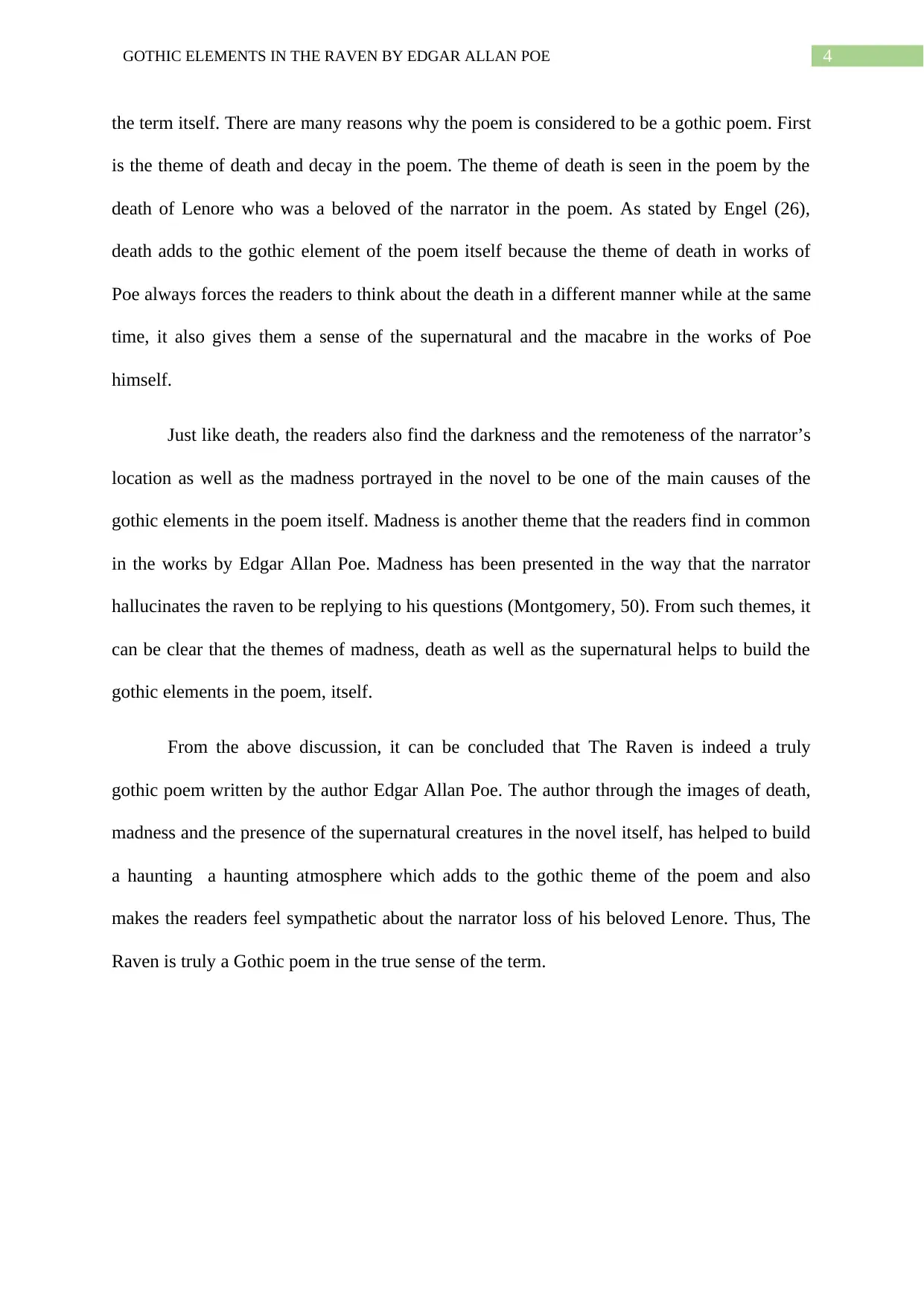
4GOTHIC ELEMENTS IN THE RAVEN BY EDGAR ALLAN POE
the term itself. There are many reasons why the poem is considered to be a gothic poem. First
is the theme of death and decay in the poem. The theme of death is seen in the poem by the
death of Lenore who was a beloved of the narrator in the poem. As stated by Engel (26),
death adds to the gothic element of the poem itself because the theme of death in works of
Poe always forces the readers to think about the death in a different manner while at the same
time, it also gives them a sense of the supernatural and the macabre in the works of Poe
himself.
Just like death, the readers also find the darkness and the remoteness of the narrator’s
location as well as the madness portrayed in the novel to be one of the main causes of the
gothic elements in the poem itself. Madness is another theme that the readers find in common
in the works by Edgar Allan Poe. Madness has been presented in the way that the narrator
hallucinates the raven to be replying to his questions (Montgomery, 50). From such themes, it
can be clear that the themes of madness, death as well as the supernatural helps to build the
gothic elements in the poem, itself.
From the above discussion, it can be concluded that The Raven is indeed a truly
gothic poem written by the author Edgar Allan Poe. The author through the images of death,
madness and the presence of the supernatural creatures in the novel itself, has helped to build
a haunting a haunting atmosphere which adds to the gothic theme of the poem and also
makes the readers feel sympathetic about the narrator loss of his beloved Lenore. Thus, The
Raven is truly a Gothic poem in the true sense of the term.
the term itself. There are many reasons why the poem is considered to be a gothic poem. First
is the theme of death and decay in the poem. The theme of death is seen in the poem by the
death of Lenore who was a beloved of the narrator in the poem. As stated by Engel (26),
death adds to the gothic element of the poem itself because the theme of death in works of
Poe always forces the readers to think about the death in a different manner while at the same
time, it also gives them a sense of the supernatural and the macabre in the works of Poe
himself.
Just like death, the readers also find the darkness and the remoteness of the narrator’s
location as well as the madness portrayed in the novel to be one of the main causes of the
gothic elements in the poem itself. Madness is another theme that the readers find in common
in the works by Edgar Allan Poe. Madness has been presented in the way that the narrator
hallucinates the raven to be replying to his questions (Montgomery, 50). From such themes, it
can be clear that the themes of madness, death as well as the supernatural helps to build the
gothic elements in the poem, itself.
From the above discussion, it can be concluded that The Raven is indeed a truly
gothic poem written by the author Edgar Allan Poe. The author through the images of death,
madness and the presence of the supernatural creatures in the novel itself, has helped to build
a haunting a haunting atmosphere which adds to the gothic theme of the poem and also
makes the readers feel sympathetic about the narrator loss of his beloved Lenore. Thus, The
Raven is truly a Gothic poem in the true sense of the term.
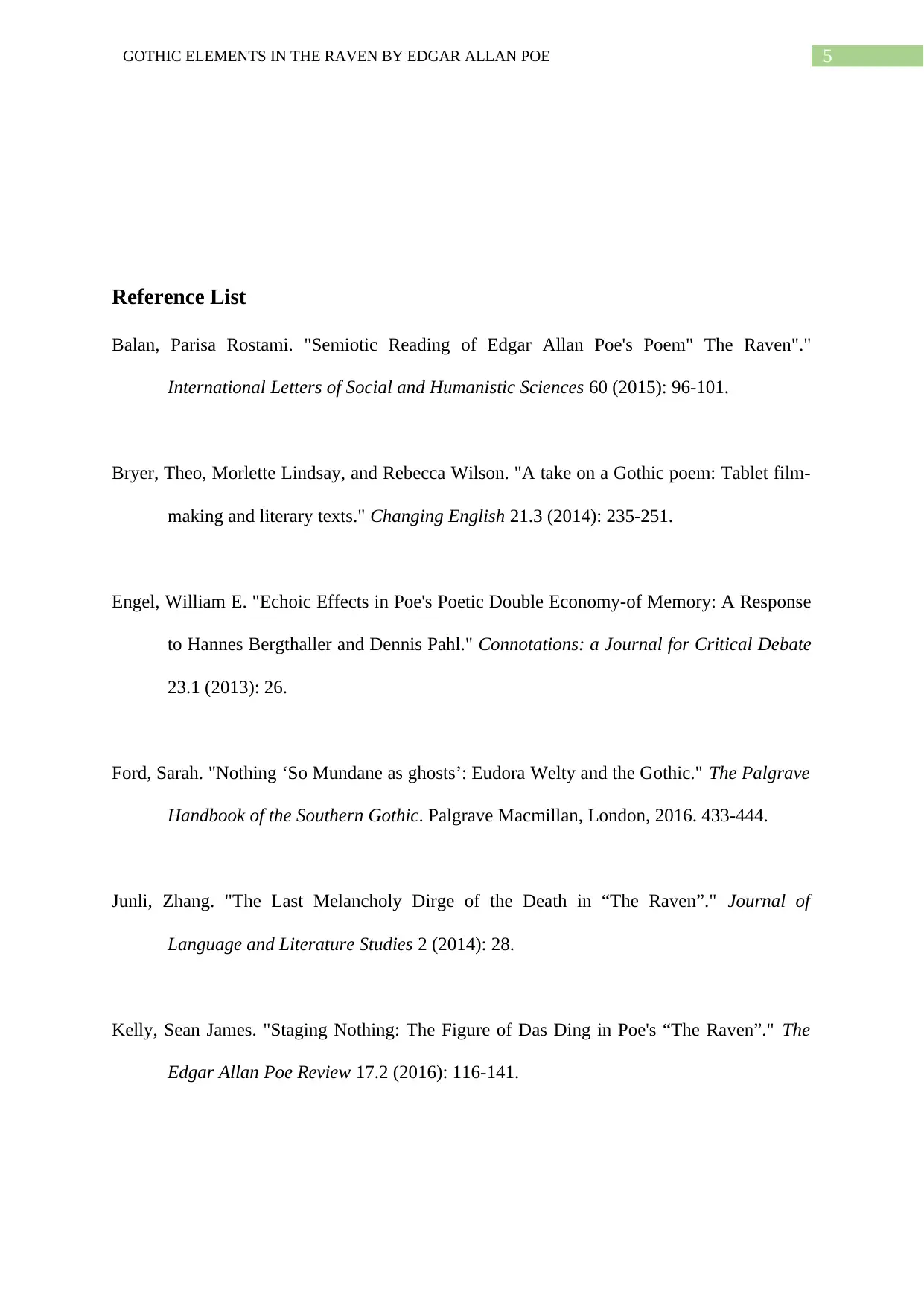
5GOTHIC ELEMENTS IN THE RAVEN BY EDGAR ALLAN POE
Reference List
Balan, Parisa Rostami. "Semiotic Reading of Edgar Allan Poe's Poem" The Raven"."
International Letters of Social and Humanistic Sciences 60 (2015): 96-101.
Bryer, Theo, Morlette Lindsay, and Rebecca Wilson. "A take on a Gothic poem: Tablet film-
making and literary texts." Changing English 21.3 (2014): 235-251.
Engel, William E. "Echoic Effects in Poe's Poetic Double Economy-of Memory: A Response
to Hannes Bergthaller and Dennis Pahl." Connotations: a Journal for Critical Debate
23.1 (2013): 26.
Ford, Sarah. "Nothing ‘So Mundane as ghosts’: Eudora Welty and the Gothic." The Palgrave
Handbook of the Southern Gothic. Palgrave Macmillan, London, 2016. 433-444.
Junli, Zhang. "The Last Melancholy Dirge of the Death in “The Raven”." Journal of
Language and Literature Studies 2 (2014): 28.
Kelly, Sean James. "Staging Nothing: The Figure of Das Ding in Poe's “The Raven”." The
Edgar Allan Poe Review 17.2 (2016): 116-141.
Reference List
Balan, Parisa Rostami. "Semiotic Reading of Edgar Allan Poe's Poem" The Raven"."
International Letters of Social and Humanistic Sciences 60 (2015): 96-101.
Bryer, Theo, Morlette Lindsay, and Rebecca Wilson. "A take on a Gothic poem: Tablet film-
making and literary texts." Changing English 21.3 (2014): 235-251.
Engel, William E. "Echoic Effects in Poe's Poetic Double Economy-of Memory: A Response
to Hannes Bergthaller and Dennis Pahl." Connotations: a Journal for Critical Debate
23.1 (2013): 26.
Ford, Sarah. "Nothing ‘So Mundane as ghosts’: Eudora Welty and the Gothic." The Palgrave
Handbook of the Southern Gothic. Palgrave Macmillan, London, 2016. 433-444.
Junli, Zhang. "The Last Melancholy Dirge of the Death in “The Raven”." Journal of
Language and Literature Studies 2 (2014): 28.
Kelly, Sean James. "Staging Nothing: The Figure of Das Ding in Poe's “The Raven”." The
Edgar Allan Poe Review 17.2 (2016): 116-141.
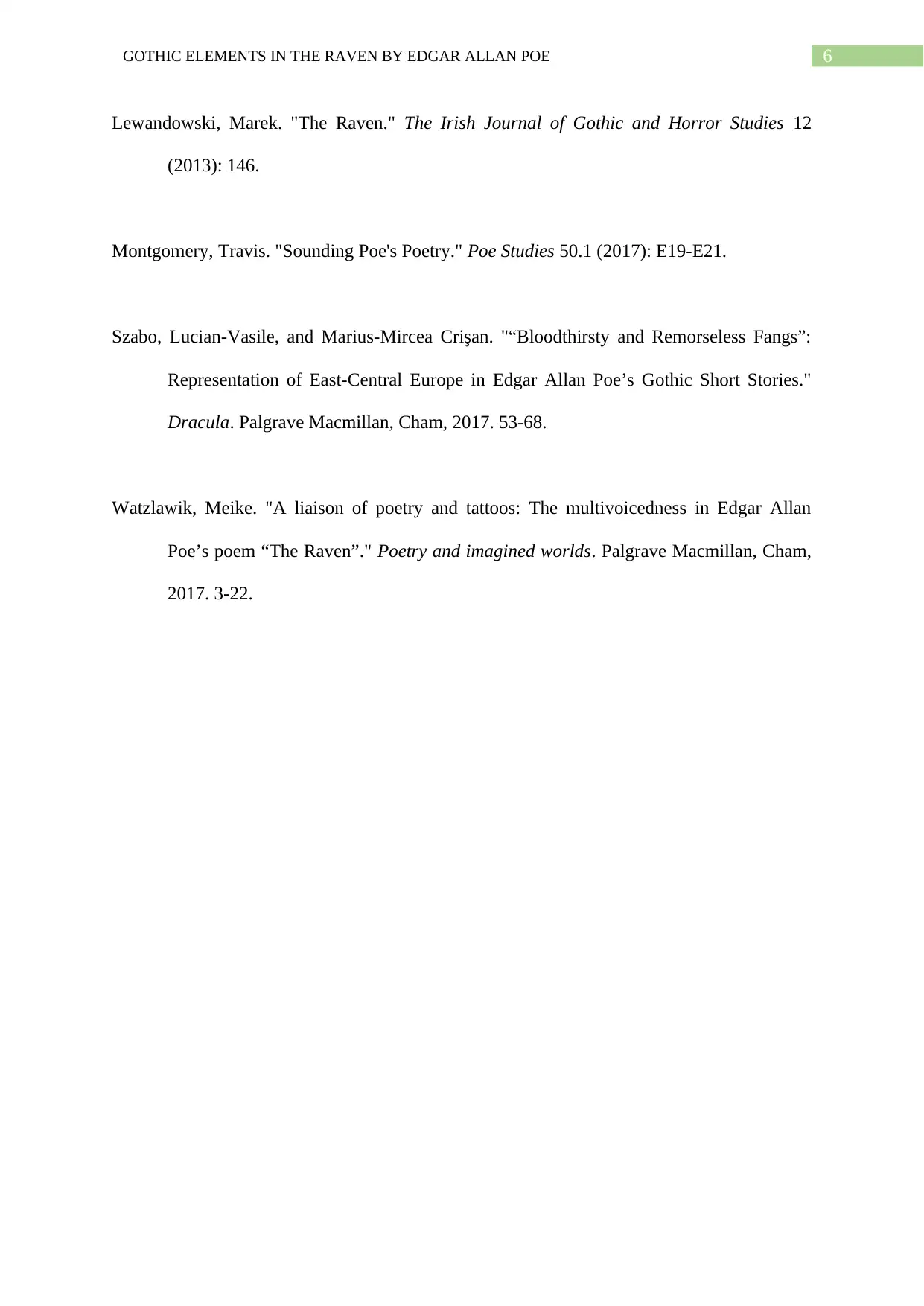
6GOTHIC ELEMENTS IN THE RAVEN BY EDGAR ALLAN POE
Lewandowski, Marek. "The Raven." The Irish Journal of Gothic and Horror Studies 12
(2013): 146.
Montgomery, Travis. "Sounding Poe's Poetry." Poe Studies 50.1 (2017): E19-E21.
Szabo, Lucian-Vasile, and Marius-Mircea Crişan. "“Bloodthirsty and Remorseless Fangs”:
Representation of East-Central Europe in Edgar Allan Poe’s Gothic Short Stories."
Dracula. Palgrave Macmillan, Cham, 2017. 53-68.
Watzlawik, Meike. "A liaison of poetry and tattoos: The multivoicedness in Edgar Allan
Poe’s poem “The Raven”." Poetry and imagined worlds. Palgrave Macmillan, Cham,
2017. 3-22.
Lewandowski, Marek. "The Raven." The Irish Journal of Gothic and Horror Studies 12
(2013): 146.
Montgomery, Travis. "Sounding Poe's Poetry." Poe Studies 50.1 (2017): E19-E21.
Szabo, Lucian-Vasile, and Marius-Mircea Crişan. "“Bloodthirsty and Remorseless Fangs”:
Representation of East-Central Europe in Edgar Allan Poe’s Gothic Short Stories."
Dracula. Palgrave Macmillan, Cham, 2017. 53-68.
Watzlawik, Meike. "A liaison of poetry and tattoos: The multivoicedness in Edgar Allan
Poe’s poem “The Raven”." Poetry and imagined worlds. Palgrave Macmillan, Cham,
2017. 3-22.
1 out of 7
Related Documents
Your All-in-One AI-Powered Toolkit for Academic Success.
+13062052269
info@desklib.com
Available 24*7 on WhatsApp / Email
![[object Object]](/_next/static/media/star-bottom.7253800d.svg)
Unlock your academic potential
© 2024 | Zucol Services PVT LTD | All rights reserved.





